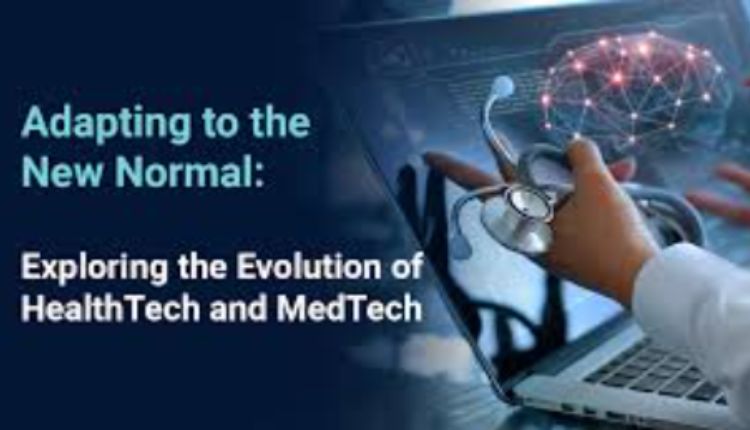The healthcare landscape is undergoing a seismic shift. As we navigate through 2025, one thing is clear — technology is no longer a supplementary tool but a core component of effective patient care. From artificial intelligence-driven diagnostics to data-secure blockchain systems, the integration of digital tools in healthcare is reshaping how services are delivered and experienced. For healthcare providers, tech startups, and policymakers, staying ahead of these innovations isn’t just an option; it’s a competitive necessity.
Central to this transformation is the growing demand for bespoke digital solutions. Businesses in the healthcare sector increasingly partner with dedicated specialists in healthtech software development to create tailored applications, systems, and platforms that meet unique clinical and operational needs. These custom-built solutions, whether it’s an AI-powered decision support tool or a remote patient monitoring dashboard, ensure healthcare organizations remain agile and future-ready.
Equally crucial is the role of a versatile software development company capable of translating complex medical requirements into user-friendly digital systems. Such companies serve as strategic allies for hospitals, research centers, and pharmaceutical firms seeking to harness the full potential of digital health innovations.
So, what exactly is propelling this surge of technological breakthroughs in healthcare? Let’s explore the top five healthtech trends transforming patient care in 2025.
Trend #1: AI-Powered Diagnostics and Predictive Analytics
Artificial intelligence has rapidly moved from theoretical applications to practical tools improving diagnosis and patient management. In 2025, AI is at the forefront of medical imaging, pathology analysis, and chronic disease prediction.
AI-driven diagnostics utilize machine learning algorithms trained on vast datasets, enabling them to identify patterns and anomalies with exceptional precision. For instance, AI-powered imaging software now assists radiologists by highlighting potential tumor growth or early signs of neurological disorders on MRI and CT scans. These tools not only speed up diagnosis but also reduce human error.
Predictive analytics complements these diagnostic capabilities by forecasting patient outcomes based on historical data and real-time inputs. Hospitals use predictive models to estimate which patients are at risk of readmission, while primary care providers monitor chronic disease progression remotely. According to a 2025 report by HealthTech Insights, over 60% of major healthcare systems have integrated predictive analytics into their clinical decision-making processes.
Key Applications of AI in Healthcare:
- Automated image analysis for faster diagnoses
- Predictive modeling for patient risk assessment
- AI chatbots for symptom checking and triage
- Personalized treatment recommendations based on genomic data
Case Study: Mayo Clinic’s AI Imaging System In 2024, Mayo Clinic introduced an AI-based radiology platform capable of detecting early-stage lung cancer with 94% accuracy. By integrating predictive analytics, the system alerts oncologists when high-risk patients require immediate follow-ups, resulting in a 20% increase in early cancer detections.
Trend #2: Telemedicine and Remote Patient Monitoring
Telehealth services surged during the COVID-19 pandemic, and in 2025, they have cemented their role in mainstream care delivery. Beyond virtual consultations, the sector’s rapid expansion now includes comprehensive remote patient monitoring (RPM) programs.
RPM involves the use of connected devices like smart blood pressure monitors, glucose meters, and wearable ECG patches that transmit real-time data to healthcare providers. This continuous health tracking allows for proactive interventions, especially for chronic conditions like diabetes, hypertension, and heart disease.
A survey by Global HealthTech Data (2025) revealed that 78% of healthcare providers offer RPM services, with patient satisfaction rates exceeding 85%. This growing acceptance is fueled by convenience, reduced hospital visits, and improved health outcomes.
Benefits of Telemedicine and RPM:
- Greater access to care in rural and underserved areas
- Enhanced patient engagement and adherence to treatment plans
- Real-time monitoring and early detection of complications
- Cost reduction by minimizing hospital admissions
Statistics:
| Metric | Value in 2025 |
|---|---|
| Global telehealth market value | $243 billion |
| Teleconsultation growth rate | 21.6% annually |
| RPM adoption among clinics | 78% |
This trend also highlights the importance of secure, interoperable platforms developed by expert software teams. Custom telehealth portals and RPM dashboards, created through dedicated healthtech software development, are critical for maintaining data integrity and seamless patient-provider communication.
Trend #3: Blockchain for Healthcare Data Security
Healthcare systems manage sensitive patient information — from personal details to genomic data — making cybersecurity a top priority. Enter blockchain technology, a decentralized, tamper-proof ledger system, poised to revolutionize data security in healthcare.
In 2025, blockchain isn’t just a concept but a practical solution adopted by hospitals and insurers to secure electronic health records (EHR), streamline insurance claims, and verify drug supply chains.
Why Blockchain Matters in Healthcare:
- Enhanced Data Integrity: Every transaction or data entry is encrypted and linked to previous records, creating an unalterable audit trail.
- Interoperability: Blockchain enables seamless data sharing across different healthcare providers without risking data breaches.
- Fraud Prevention: The technology minimizes billing fraud and counterfeit drug circulation.
Example: MedRec Blockchain Pilot A pilot program called MedRec, launched in several U.S. hospitals, uses blockchain to manage patient consent and securely share EHRs across facilities. The system has reduced administrative costs by 15% and improved data accuracy rates.
Trend #4: Personalized Medicine and Genomics
2025 marks a defining era for personalized medicine, where treatment plans are increasingly tailored to individual genetic profiles, lifestyle habits, and biometric data. Thanks to advancements in genomics and big data analytics, healthcare is moving away from one-size-fits-all protocols toward hyper-personalized interventions.
What is Personalized Medicine? It’s a medical model that customizes healthcare — decisions, practices, and therapies — for the individual patient. By analyzing a person’s genetic makeup alongside clinical and environmental data, doctors can predict disease risk, choose optimal medications, and preempt adverse reactions.
Technologies Driving This Trend:
- Genomic Sequencing: Accessible whole-genome sequencing (WGS) allows for risk assessment of hereditary conditions.
- AI-Based Treatment Algorithms: Machine learning predicts which therapies are most effective based on similar patient profiles.
- Biomarker Analysis: Identifies biological indicators to monitor disease progression and treatment response.
Use Cases:
- Oncology: Tumor genomic profiling tailors chemotherapy combinations for maximum efficacy with fewer side effects.
- Cardiology: Genetic testing identifies patients susceptible to heart arrhythmias, enabling early preventive care.
- Rare Diseases: Personalized drug formulations based on unique mutations improve survival rates.
Table: Popular Applications of Personalized Medicine in 2025
| Specialty | Application | Benefit |
|---|---|---|
| Oncology | Tumor DNA sequencing | Custom chemotherapy plans |
| Cardiology | Genetic arrhythmia risk screening | Early intervention treatments |
| Neurology | Alzheimer’s gene marker detection | Lifestyle adjustments, drugs |
The expansion of this trend relies on sophisticated platforms developed by expert healthtech software teams. From AI-powered risk prediction dashboards to integrated genomic data repositories, these tools ensure clinicians can act on complex data sets with confidence and clarity.
Trend #5: Smart Wearables and IoT in Patient Care
Wearable technology has exploded in popularity, evolving from fitness trackers to sophisticated health-monitoring devices integrated within the Internet of Things (IoT) ecosystem. In 2025, smart wearables provide round-the-clock insights into vital signs, activity levels, and sleep patterns, offering immense potential for both preventive care and chronic disease management.
How Wearables are Changing Healthcare:
- Real-Time Health Tracking: Devices like ECG-enabled smartwatches detect arrhythmias instantly, alerting both the user and their doctor.
- Continuous Glucose Monitors (CGMs): Help diabetics maintain better blood sugar control with predictive alerts.
- Smart Inhalers: Track inhalation data for asthma and COPD patients to improve adherence and identify triggers.
Benefits of IoT in Healthcare:
- Increased patient empowerment and health literacy
- Data-driven clinical decisions based on continuous, real-world evidence
- Reduced hospitalizations through early intervention
2025 Stats:
- Global smart healthcare market: $192 billion
- Wearable health device users: Over 500 million
- Most monitored vitals: Heart rate, blood pressure, glucose levels
Key Insight:
These devices, often developed in collaboration with seasoned healthtech software providers, feed data into EHR-integrated platforms, ensuring seamless analysis and actionable reporting. It highlights the critical role a capable software development company plays in connecting IoT infrastructure with health systems.
The Role of HealthTech Software Development Companies
Behind every innovative healthcare technology is a development team translating clinical visions into functional, scalable software. In 2025, the demand for tailored digital solutions in healthcare has skyrocketed, making the selection of the right software development company crucial.
Why Custom Software is Essential:
- Standard off-the-shelf products often lack the flexibility needed for specific clinical workflows.
- Regulatory compliance (HIPAA, GDPR) demands precision and security that only bespoke systems can guarantee.
- Interoperability challenges require systems that seamlessly integrate with diverse EHRs, imaging systems, and patient apps.
Traits of a Top HealthTech Development Partner:
- Deep knowledge of healthcare regulations and data privacy protocols
- Experience with emerging tech like AI, IoT, blockchain
- Proven track record in building scalable, interoperable platforms
- Agile development methodologies for rapid deployment and iteration
- Strong user-experience (UX) design capabilities tailored for clinicians and patients
Example:
Famed European digital health platform MediChain partnered with a specialist software firm to develop its blockchain-based health data management system, reducing data breaches by 40% and cutting administrative overhead by 25%.
Benefits of Embracing HealthTech Trends for Healthcare Providers
The financial and operational incentives for adopting healthtech innovations are clear. Forward-thinking healthcare organizations report improved patient satisfaction, better clinical outcomes, and leaner operations through digital transformation.
Operational Benefits:
- Reduced appointment no-shows via telehealth and automated reminders
- Fewer hospital admissions through RPM and predictive analytics
- Lower overhead costs through process automation
Clinical Advantages:
- Enhanced diagnostic accuracy with AI imaging and decision support
- Quicker treatment adjustments via real-time monitoring
- Data-driven care plans using wearable and genomics data
Patient-Centric Gains:
- Greater autonomy with access to personal health data
- Improved care coordination between multiple providers
- More personalized and timely interventions
Key Insight:
Organizations collaborating with experienced healthtech software developers find it easier to innovate rapidly, integrating new features and scaling infrastructure as patient demands and technologies evolve.
Challenges and Risks in HealthTech Adoption
As promising as digital health innovations are, they come with hurdles that healthcare providers and technology firms must navigate.
Major Challenges:
- Regulatory Compliance: Adhering to healthcare regulations across multiple regions can delay product launches.
- Data Privacy and Cybersecurity: Protecting sensitive patient data from cyber threats remains a constant challenge.
- Digital Divide: Not all patient demographics have equal access to digital health tools, risking care inequity.
- Change Management: Clinician resistance to new workflows can hinder adoption and ROI.
Risk Mitigation Strategies:
- Partner with compliance-savvy software developers
- Invest in robust cybersecurity measures
- Design user-friendly, inclusive digital tools
- Offer comprehensive staff training programs
Statistic:
A 2025 HIMSS survey found that 62% of healthcare executives cited change resistance and integration difficulties as their biggest obstacles in digital health projects.
Future Outlook: What’s Next Beyond 2025?
While 2025 feels like a pinnacle year for healthtech innovation, the horizon beyond it is even more electrifying. The intersection of biotechnology, AI, and decentralized data ecosystems will continue to reshape healthcare delivery models, policy frameworks, and patient expectations.
Predicted Trends Beyond 2025:
- AI + Biotech Integration: Combining AI’s pattern recognition with biotech advancements like CRISPR will usher in an era of hyper-personalized, gene-editing treatments for genetic diseases and certain cancers.
- Decentralized Health Data Marketplaces: Patients will gain unprecedented control over their personal health data, trading anonymized insights to pharmaceutical companies and research institutes via secure blockchain-based platforms.
- AI-Driven Robotic Surgeries: Smarter, more autonomous surgical robots capable of handling intricate procedures with minimal human oversight.
- Policy Evolution: Global health authorities are expected to harmonize data privacy regulations, easing cross-border health data sharing and telehealth services.
This anticipated future underscores the importance for healthcare providers and software firms alike to remain agile, prioritize interoperability, and foster continuous innovation.
Global Market Overview and Investment Trends
HealthTech isn’t just evolving clinically — it’s booming economically. As of 2025, global digital health investments reached record-breaking levels, with private equity firms, venture capitalists, and governments channeling billions into AI diagnostics, telemedicine, and genomics ventures.
2025 HealthTech Market Figures:
- Global market valuation: $680 billion
- Telehealth sector value: $243 billion
- AI in healthcare market: $110 billion
Top Innovation Hubs:
- United States (Silicon Valley, Boston)
- Israel (Tel Aviv)
- United Kingdom (London)
- Germany (Berlin)
- Singapore (Asia-Pacific gateway)
Investment Hotspots:
- AI-powered clinical decision support
- Genomic sequencing platforms
- Blockchain-based health data networks
- Smart wearable startups
The proliferation of strategic alliances between health providers and healthtech software development companiesfurther validates the sector’s long-term viability and resilience.
Conclusion
The digital transformation of healthcare in 2025 is not just a fleeting trend — it’s a structural shift reshaping the future of medicine. From AI diagnostics to blockchain-protected records and personalized medicine, these innovations enhance efficiency, accuracy, and most importantly, patient outcomes.
The symbiotic relationship between healthcare institutions and expert healthtech software development partners ensures the seamless, compliant, and patient-centered rollout of these technologies. As the demand for digital health services grows, forward-thinking providers must embrace these tools not only for operational gains but for their transformative impact on human lives.
In a sector where every second matters, the difference between reactive care and proactive intervention often lies in the quality of the digital systems underpinning it. The time to invest, innovate, and lead is now.






